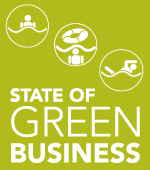Bioplastics Become Material
<p>A steady parade of innovators in large and small companies have tried to create more environmentally benign alternatives to plastic; after decades of slow progress, bioplastics are sprouting like weeds.</p>

[Editor's Note: This is the last part of a 10-part series of articles excerpted from our annual State of Green Business Report. The report takes a close look at the data behind the green business movement to track whether we're moving the needle on corporate sustainability. Download the free report here.]
For years, the search for alternatives to petroleum-based plastics has led researchers down a variety of paths, many of which turned out to be dead ends. Henry Ford, the automaker and showman, produced a prototype plastic car made from soybeans in 1941, but plastic from plants wilted as plastic from oil gained favor as a substitute for scarce steel during World War II.
Since the 1970s, as concern over plastic's environmental impacts grew in lockstep with the growth of plastic itself, a steady parade of innovators in both large and small companies have tried to create more environmentally benign alternatives. Few succeeded, failing to meet the demanding price and performance specifications of today's manufacturers. Now suddenly, bioplastics made from plants and agricultural materials are sprouting like -- well, weeds.
Introductions of bioplastic materials and products reached a crescendo during 2010, as more mainstream companies introduced bioplastics from a dizzying array of commodities. Beverage maker Odwalla, a Coca-Cola subsidiary, said it was switching all of its single-serve drinks to bottles made almost entirely of plastic derived from molasses and sugarcane juice. (In 2009, Coke announced it would begin phasing in a similar bioplastic bottle for its flagship cola.)
Procter & Gamble is bringing sugarcane to shampoo and makeup with new packaging that will be on shelves next year. The company will start using sugarcane-based plastic packaging for certain products from its Pantene Pro-V, Covergirl and Max Factor brands, made with ethanol derived from Brazilian sugarcane.
Sugarcane is just the start. Electronics company NEC said it developed a bioplastic made with an extract from non-edible cashew nut shells and plant cellulose that is twice as strong as another bioplastic typically made from corn starch. The company says its material is not just doubly strong, but also more than twice as heat-resistant and molds in half the time as bio-plastic made from polylactic acid resin, which is typically derived from corn starch or sugarcane.
Organic yogurt maker Stonyfield Farm began switching its multi-packs to corn-based bioplastic and will fund the planting of enough non-genetically modified corn crops to equal the amount of corn used in the new packaging. (About 85 percent of U.S.-grown corn is genetically modified.) The company was able to offset the extra costs of the bioplastic packaging because it is stronger than the oil-based plastic it replaces, and offers some other performance characteristics. For example, it reduces breakage during shipping and forms a tighter seal with the lid. The plastic is stronger than polystyrene, so less is needed, making packages lighter. Because of PLA's higher efficiencies and lower losses, the shift to plant-based plastics was done at no net cost increase to Stonyfield.
Ford said it was using foam derived from soy instead of petroleum and would expand the use of bio-based foams through nearly all of its vehicle lineup with an eye toward one day using compostable plastics. British snack company Walkers said it was looking into transforming potato peelings into crisp (chip) packets.
Two Texas companies teamed up to turn some of the 50 million coconuts that fall from trees each year into reusable packaging. Whole Tree has been researching uses for coconut husks for about two years, partnering with packaging firm Compadre to design and test different uses for coconut-based materials.
And then there's the packaging material made of mushroom roots and agricultural waste from a startup called Ecovative Design. It makes packaging by growing mushroom fibers on wastes like cottonseed, wood fiber, and buckwheat hulls. Its EcoCradle technology already consumes one-tenth the energy used to manufacture foam packaging, but a new version, made with a blend of cinnamon bark oil, thyme oil, oregano oil, and lemongrass oil, lowers its energy needs to just 1/40th of foam's. The company's packaging is being used by some big companies, including office furniture maker Steelcase, which last year began shipping products packed in EcoCradle.
Bringing bioplastics to scale in the marketplace will take more than innovators playing with coconuts and mushrooms. It will also require thinking through the "end of life" scenarios so that bioplastics can either be integrated into existing plastics recycling or sent to municipal composting facilities. At present, bioplastics can contaminate conventional plastics sent to recycling, and the low volume of bioplastics in use does not give recyclers much incentive to invest in new technologies for identifying and separating bioplastics. Meanwhile, the composting infrastructure is nascent in the U.S. overall, though one study found that most facilities accept compostable packaging.
Those problems aside, innovative packaging of any kind can occasionally have downsides, and that's equally true of bioplastic packaging. Consider the fate of SunChips, the snack food made by Pepsico subsidiary Frito-Lay. In 2010, it introduced a long-anticipated package made from a corn-based polymer.
So far, so good. But the bag turned out to be noisy -- so noisy, in fact, that it engendered consumer complaints. (It also became a social media phenomenon, with a Facebook group called SORRY BUT I CAN'T HEAR YOU OVER THIS SUN CHIPS BAG garnering more than 50,000 fans.) Frito-Lay ended up sacking the clamorous chip bag.
Consumers, it seems, want their packaging green -- soft green.






